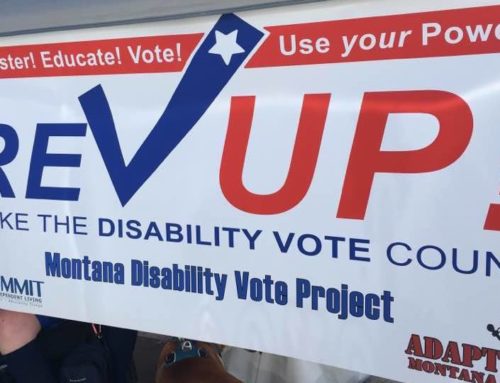Recent Facebook Post:
Sometimes advocating for your health care means staying diligent with meds, tracking symptoms, and recruiting coping skills. Sometimes it means reaching out, activating your support network, and contacting your care team. And sometimes it means showing up to your doctor’s office unannounced, in tears, and staying until someone really listens, making them understand, and being taken seriously.
I posted that after an extremely hard day of managing my mental health. “You are my last stop before the emergency room,” I blubbered to the receptionist. She stopped typing to hear my stunted words. She showed sympathy. “Hold on,” she cooed. “I’ve got someone you can talk to.”
Advocacy is an art. At best, it demands responses and awakens folks. At worst, it seems I’m using my disability to be an ass. I wish there was language for advocacy, but there isn’t. Still, I can do things. Providers can do things. Hopefully, we meet in the middle. Unfortunately, that day at the doctor’s was not so ideal.
A week earlier, I emailed for help. The new drug stopped working; symptoms returned. I expected a dosage increase. However, this was my doctor’s his first work with my team, and he balked. A routine response: A missed a dose? (Nope.) Take meds at the same time daily? (Yep.) He was being diligent, but 20 years of questions makes this patient impatient. I don’t get a pass that says, “She knows her condition; trust her instincts.” In my next email, I pressed the issue: I’m dosing correctly.
I need a med change.
Email works because I become nonverbal when symptoms spike. Plus, I have a fiery trigger from botched med trials. I’m engulfed in med problem panic attacks. I hoped my second email would cinch that dose increase.
The next day a different doc replied (one I would see in a week – for a pap smear). Are hoo-hoos part of mental health care now? The confusion didn’t stop there. She reviewed the normal side effects of birth control and suggested I buy a pregnancy test. My husband had a vasectomy and my only swinging is between panic and depression. Obviously, she ’didn’t read the previous emails. I had to advocate as clearly as possible, even teetering on the edge of panic.
I started my reply: “Really?! All I need is to wave a prego dipstick and someone listens?” Delete… Instead, I wrote, “I can be clearer about my symptoms.” And I was. Sparing none of the gory details, I referenced my 5 years’ work with their colleague in the behavioral health unit, our agreement to include my medical doctor, and the birth control issue. P.S. I’d like a dose increase. Panic struck the next morning. Hubby called, but the nurse ’needed permission to talk to him.’ I gave it; retching words out while I could. I eavesdropped as hubby updated her. “The doctor is out until Monday,” she said. “Hold on over the weekend. He’ll see your chart Monday and call you.”
Monday a hurried office aid called. “There is no higher dose,” she announced. “How about working with our behavioral unit? “ Before I could process the loop I had landed in, she rushed to finish. “You can follow up at your next visit.” “Wait,” I yanked her back. “Are you responding to my email or the call to the nurse?” “Oh,” she said. “We don’t do email.”
Two hours later – a week after my first email – I showed up at their front desk. My unexpected visit meant I had to repeat the debacle 4 times with 4 people while sobbing and hiding my pain under a calm mask.
I walked out with a higher dose.
Within 48 hours I was myself again. Within 72 I brainstormed advocating better. I wrote an Advocacy Action List. These tactics convey critical details in an accessible format in the provider’s language so we can pursue healing right away.
Advocacy Action List
- Compile a master list of doctors’ numbers, medications, symptoms, and possible actions. Make copies. When symptoms return, snag a copy and circle the relevant info.
- Organize circled info into SBAR – doctors’ language. SBAR = Situation, Background, Assessment, Recommendation. Keep it short; 1-2 sentences max.
- Chart Symptoms. Data gets a provider’s attention. Until a relationship forms, charts, graphs, dates, and lists can create trust.
- Rally people to chaperone an appointment. Another person in the room slows doctors down, so they listen better. Friends can present the SBAR, which makes it easier to sift through details and to decide on a solution.
What Providers Can Do
Providers must know their DMS and meds, but also understand the rollercoaster of mental health. They need to feel I’m being honest about my condition, but they should earn my trust as well. Here’s what providers can do to build an effective relationship.
- Slow down and read the history. Every provider is super busy, but understanding the entire background is critical. In my fiasco, everyone was just trying to send that next email or answer that next phone call. That’s how I ended up at their front desk in tears.
- Consult with colleagues. Much time and confusion can be averted by calling another provider who can fill in important details.
- Trust me. When I reach out – via any means – I’ve already struggled with even asking for help. I’ve checked in with care plans. I’ve recruited coping skills. Now I need your expertise.
For me, the hardest part about advocacy is that I need it most when I’m least able to do it well. I learned a lot this go-around. I know my body best. I’m the one who must make providers understand. I have to speak their language. After the storm passes, seeing me calm and well, they realize their trust was not in vain. For example, at that follow-up visit for my pap smear, the doctor started with a gentle check-in. I expressed my frustration. I stuck up for myself while remaining kind. As she reached for the pressure cuff, doc gave a confident nod. “Oh yeah, you just needed a higher dose.”
EDITOR’S NOTE: After submitting the above article, the author wrote the provider describing her experience and requesting policy change. She received a response letter with an apology and gratitude for the feedback, which will be used to improve patient care.






